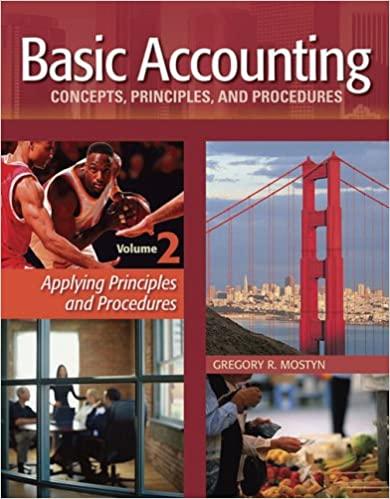Answered step by step
Verified Expert Solution
Question
1 Approved Answer
Bender Industries, reported the following account balances on January 1. Debit Credit Accounts Receivable $ 5,000 Accumulated Depreciation $ 30,000 Additional Paid-in Capital 92,000 Allowance
Bender Industries, reported the following account balances on January 1.
| Debit | Credit | |
|---|---|---|
| Accounts Receivable | $ 5,000 | |
| Accumulated Depreciation | $ 30,000 | |
| Additional Paid-in Capital | 92,000 | |
| Allowance for Doubtful Accounts | 2,000 | |
| Bonds Payable | 0 | |
| Buildings | 249,000 | |
| Cash | 10,500 | |
| Common Stock, 10,000 shares of $1 par | 10,000 | |
| Notes Payable (long-term) | 10,500 | |
| Retained Earnings | 120,000 | |
| Treasury Stock | 0 | |
| TOTALS | $ 264,500 | $ 264,500 |
The company entered into the following transactions during the year.
| January 15 | Issued 6,000 shares of $1 par common stock for $52,000 cash. |
|---|---|
| January 31 | Collected $3,000 from customers on account. |
| February 15 | Reacquired 3,020 shares of $1 par common stock into treasury for $33,220 cash. |
| March 15 | Reissued 2,020 shares of treasury stock for $24,220 cash. |
| August 15 | Reissued 600 shares of treasury stock for $4,600 cash. |
| September 15 | Declared (but did not yet pay) a $1 cash dividend on each outstanding share of common stock. |
| October 1 | Issued 100, 10-year, $1,020 bonds, at a quoted bond price of 101. |
| October 3 | Wrote off a $1,500 balance due from a customer who went bankrupt. |
| December 29 | Recorded $232,000 of service revenue, all of which was collected in cash. |
| December 30 | Paid $202,000 cash for this years wages through December 31. (Ignore payroll taxes and payroll deductions.) |
| December 31 | Calculated $10,000 of depreciation for the year to be recorded. (Ignore accrual adjustments for interest and income taxes.) |
The option you choose will be the values used to populate the balance sheet tabs.
UnadjustedAdjustedPost-closing
| BENDER INDUSTRIES | ||
| Trial Balance | ||
| December 31, 2022 | ||
| Account Title | Debit | Credit |
|---|---|---|
| Cash | 10,500 | |
| Accounts Receivable | 5,000 | |
| Allowance for Doubtful Accounts | 2,000 | |
| Buildings | 249,000 | |
| Accumulated Depreciation-Buildings | 30,000 | |
| Notes Payable (long-term) | 10,500 | |
| Common Stock | 10,000 | |
| Additional Paid-In Capital, Common Stock | 92,000 | |
| Retained Earnings | 120,000 | |
| Total | 264,500 | 264,500 |
Use the dropdowns to select the accounts properly included on the classified balance sheet. However, you will need to enter the amount of Retained earnings. At the end of the year, the adjusted net income was $20,000.
| |||||||||||||||
Step by Step Solution
There are 3 Steps involved in it
Step: 1

Get Instant Access to Expert-Tailored Solutions
See step-by-step solutions with expert insights and AI powered tools for academic success
Step: 2

Step: 3

Ace Your Homework with AI
Get the answers you need in no time with our AI-driven, step-by-step assistance
Get Started


